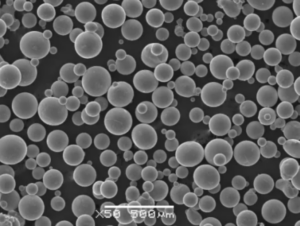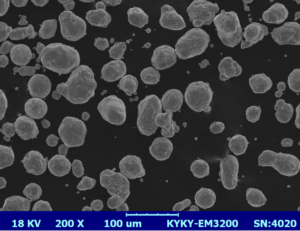Visão geral
Materiais avançados estão revolucionando o mundo da manufatura, engenharia e tecnologia. De pós metálicos usados em impressão 3D a compósitos avançados em aeroespacial, esses materiais oferecem propriedades aprimoradas que os materiais tradicionais não conseguem igualar. Eles permitem que os fabricantes criem produtos mais leves, mais fortes e mais duráveis, tudo isso enquanto melhoram a eficiência e reduzem os custos.
Neste artigo, exploraremos o mundo dos materiais avançados, com foco em pós metálicos. Mergulharemos em seus tipos, composições, propriedades e aplicações. Além disso, compararemos diferentes pós metálicos, analisaremos seus prós e contras e forneceremos especificações detalhadas e informações de preços.
Este guia será particularmente útil para engenheiros, designers e qualquer pessoa interessada nas tecnologias de ponta que estão moldando o futuro.

Tipos e Composição de Pós Metálicos Avançados
Pós metálicos avançados são usados em várias indústrias, incluindo aeroespacial, automotiva, saúde e eletrônicos. Esses pós são metais finamente divididos que, devido ao seu pequeno tamanho e alta área de superfície, exibem propriedades únicas.
Aqui está uma olhada em dez modelos específicos de pó metálico que estão liderando o caminho na fabricação moderna:
| Modelo de pó metálico | Composição | Propriedades | Formulários | Método de fabricação |
|---|---|---|---|---|
| Pó de Alumínio 6061 | Al, Mg, Si | Leve, resistente à corrosão, alta resistência | Aeroespacial, peças automotivas, componentes estruturais | Atomização de gás |
| Aço inoxidável 316L em pó | Fe, Cr, Ni, Mo | Excelente resistência à corrosão, alta resistência, boa soldabilidade | Implantes médicos, equipamentos de processamento de alimentos, aplicações marítimas | Atomização de água |
| Pó de titânio Ti-6Al-4V | Ti, Al, V | Alta relação resistência-peso, biocompatível, resistente à corrosão | Aeroespacial, implantes médicos, aplicações militares | Atomização por plasma |
| Pó Inconel 718 | Ni, Cr, Fe, Nb | Resistência a altas temperaturas, resistente à corrosão, mantém a resistência em altas temperaturas | Turbinas a gás, reatores nucleares, componentes aeroespaciais | Atomização de gás |
| Pó de Cobre C11000 | Cu | Excelente condutividade elétrica, boa condutividade térmica, resistente à corrosão | Componentes elétricos, trocadores de calor, radiadores automotivos | Refino eletrolítico |
| Pó de Cobalto-Cromo (Co-Cr) | Co, Cr, Mo | Alta resistência ao desgaste, biocompatível, resistente à corrosão | Implantes dentários, implantes ortopédicos, aeroespacial | Atomização de gás |
| Pó de alumínio AlSi10Mg | Al, Si, Mg | Leve, alta resistência, boa condutividade térmica | Automotivo, aeroespacial, ferramentas | Atomização de gás |
| Níquel 625 em pó | Ni, Cr, Mo, Nb | Excelente resistência à corrosão, boa soldabilidade, alta resistência | Aplicações marítimas, processamento químico, aeroespacial | Atomização de gás |
| Pó de Tungstênio W | C | Alta densidade, alto ponto de fusão, excelente resistência ao desgaste | Aplicações de defesa, eletrônicos, blindagem contra radiação | Redução de hidrogênio |
| Pó de Magnésio AZ91D | Mg, Al, Zn | Leve, boa relação resistência-peso, resistente à corrosão | Componentes automot | Atomização de gás |
Composição de Materiais Avançados
A composição de materiais avançados, particularmente pós metálicos, influencia significativamente as suas propriedades e aplicações. Compreender a composição elementar é crucial para selecionar o material certo para uma aplicação específica.
Pó de Alumínio 6061: Composto principalmente por alumínio, com magnésio e silício como elementos de liga. Esta combinação aumenta a resistência e a resistência à corrosão do material, tornando-o ideal para componentes estruturais.
Aço inoxidável 316L em pó: Uma liga de ferro, crómio, níquel e molibdénio. O crómio proporciona excelente resistência à corrosão, enquanto o níquel adiciona tenacidade e resistência, tornando-o adequado para ambientes médicos e marinhos.
Pó de titânio Ti-6Al-4V: Uma liga de titânio popular, contendo alumínio e vanádio. Esta liga oferece uma alta relação resistência-peso e é biocompatível, tornando-a perfeita para implantes aeroespaciais e médicos.
Pó Inconel 718: Composto por níquel, crómio e ferro, com elementos adicionais como nióbio para reforço. Esta liga pode suportar temperaturas extremas e ambientes corrosivos, ideal para turbinas a gás e reatores nucleares.
Pó de Cobre C11000: Pó de cobre puro, conhecido pela sua excelente condutividade elétrica e térmica. Isso o torna essencial para componentes elétricos e permutadores de calor.
Pó de Cobalto-Cromo (Co-Cr): Uma mistura de cobalto, crómio e molibdénio. É conhecido pela sua resistência ao desgaste e biocompatibilidade, tornando-o adequado para implantes médicos e componentes aeroespaciais de alto desgaste.
Pó de alumínio AlSi10Mg: Uma liga de alumínio com silício e magnésio, oferecendo boa resistência e condutividade térmica, comumente usada em aplicações automotivas e aeroespaciais.
Níquel 625 em pó: Uma liga de níquel, crómio, molibdénio e nióbio, oferecendo excelente resistência à corrosão e alta resistência, usada nas indústrias de processamento marinho e químico.
Pó de Tungstênio W: Tungsténio puro, conhecido pela sua alta densidade e ponto de fusão, usado em defesa, eletrónica e aplicações de blindagem contra radiação.
Pó de Magnésio AZ91D: Uma liga de magnésio com alumínio e zinco, oferecendo uma solução leve com boa resistência, usada em componentes automotivos e aeroespaciais.
Características de Materiais Avançados
Compreender as características desses pós metálicos avançados é crucial para determinar a sua adequação para aplicações específicas. Aqui está uma análise das principais características:
| Modelo de pó metálico | Densidade (g/cm³) | Ponto de fusão (°C) | Condutividade térmica (W/m-K) | Resistência à tração (MPa) |
|---|---|---|---|---|
| Pó de Alumínio 6061 | 2.70 | 582 – 652 | 167 | 310 – 350 |
| Aço inoxidável 316L em pó | 7.99 | 1371 – 1399 | 16 | 485 – 620 |
| Pó de titânio Ti-6Al-4V | 4.43 | 1604 – 1660 | 6.7 | 900 – 1200 |
| Pó Inconel 718 | 8.19 | 1290 – 1350 | 11.4 | 965 – 1185 |
| Pó de Cobre C11000 | 8.96 | 1085 | 401 | 210 – 300 |
| Pó de Cobalto-Cromo (Co-Cr) | 8.29 | 1330 – 1400 | 14.1 | 655 – 1045 |
| Pó de alumínio AlSi10Mg | 2.68 | 570 – 660 | 151 | 320 – 360 |
| Níquel 625 em pó | 8.44 | 1290 – 1350 | 9.8 | 827 – 1034 |
| Pó de Tungstênio W | 19.25 | 3422 | 173 | 1510 – 1960 |
| Pó de Magnésio AZ91D | 1.81 | 595 – 640 | 76 | 160 – 230 |
Densidade e Resistência
A densidade e a resistência à tração são parâmetros críticos na seleção de materiais para aplicações específicas. Por exemplo, Pó de Tungstênio W tem uma densidade muito alta (19,25 g/cm³) e resistência à tração (1510 – 1960 MPa), tornando-o ideal para aplicações de alto desempenho, como defesa e blindagem contra radiação. Por outro lado, Pó de Magnésio AZ91D é uma das opções mais leves, com uma densidade de 1,81 g/cm³, tornando-o perfeito para componentes automotivos leves.
Propriedades térmicas
A condutividade térmica é outra característica importante. Pó de Cobre C11000 lidera nesta área com uma condutividade térmica de 401 W/m·K, tornando-o a melhor escolha para permutadores de calor e aplicações elétricas. Por outro lado, Pó Inconel 718 e Níquel 625 em pó oferecem condutividades térmicas mais baixas, mas se destacam na resistência a altas temperaturas, tornando-os adequados para as indústrias aeroespacial e de processamento químico.

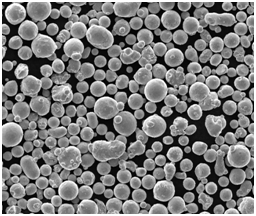
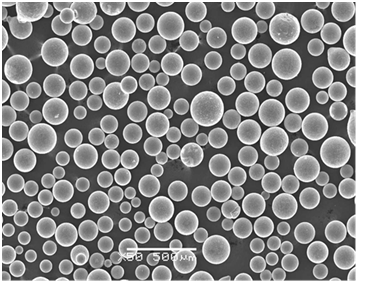


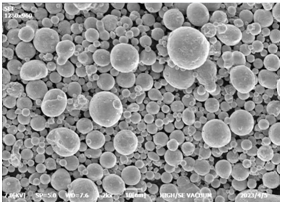
Aplicações de Pós Metálicos Avançados
Pós metálicos avançados encontram aplicações em várias indústrias devido às suas propriedades únicas. Veja como esses pós são utilizados em diferentes setores:
| Setor | Modelos de Pó Metálico Usados | Formulários |
|---|---|---|
| Aeroespacial | Titânio Ti-6Al-4V, Inconel 718, Alumínio AlSi10Mg | Componentes estruturais, peças de motor, trem de pouso |
| Automotivo | Alumínio 6061, Magnésio AZ91D, Aço Inoxidável 316L | Blocos de motor, componentes do chassi, sistemas de escape |
| Assistência médica | Aço Inoxidável 316L, Titânio Ti-6Al-4V, Cobalto-Cromo | Implantes médicos, próteses dentárias, instrumentos cirúrgicos |
| Eletrônicos | Cobre C11000, Tungsténio W, Alumínio AlSi10Mg | Contatos elétricos, dissipadores de calor, placas de circuito impresso |
| Marinha | Níquel 625, Aço Inoxidável 316L, Alumínio 6061 | Hélices, fixadores marinhos, permutadores de calor |
| Defesa | Tungsténio W, Inconel 718, Titânio Ti-6Al-4V | Munição perfurante, veículos militares, proteção balística |
| Energia | Inconel 718, Níquel 625, Cobre C11000 | Lâminas de turbina, reatores nucleares, permutadores de calor |
| Ferramentas | Cobalto-Cromo, Aço Inoxidável 316L, Alumínio 6061 | Ferramentas de corte, moldes, matrizes |
Aplicações aeroespaciais
A indústria aeroespacial depende fortemente de pós metálicos avançados devido à sua resistência superior, leveza e resistência a altas temperaturas. Por exemplo, Pó de titânio Ti-6Al-4V é usado em componentes críticos como peças de motor e trem de pouso, onde a resistência e o peso são fundamentais. Pó Inconel 718 é usado em lâminas de turbina devido à sua capacidade de suportar temperaturas extremas.
Aplicações automotivas
Na indústria automotiva, a necessidade de materiais leves e duráveis é crucial para melhorar a eficiência de combustível e o desempenho. Pó de Alumínio 6061 e Pó de Magnésio AZ91D são escolhas populares para blocos de motor e componentes do chassi, oferecendo um bom equilíbrio entre resistência e peso. Aço inoxidável 316L em pó é usado em sistemas de escape por sua resistência à corrosão.
Especificações, tamanhos e padrões
Selecionar o pó metálico certo requer a compreensão de suas especificações, tamanhos e adesão aos padrões da indústria. Aqui está uma visão geral detalhada:
| Modelo de pó metálico | Tamanho típico das partículas (µm) | Padrões | Notas disponíveis |
|---|---|---|---|
| Pó de Alumínio 6061 | 20 – 63 | ASTM B928/B928M | AA 6061, AlMg1SiCu |
| Aço inoxidável 316L em pó | 15 – 45 | ASTM A240/A240M | 316L, 1.4404 |
| Pó de titânio Ti-6Al-4V | 25 – 75 | ASTM F1472 | 5ª série, 23ª série |
| Pó Inconel 718 | 10 – 53 | ASTM B637 | N07718 |
| Pó de Cobre C11000 | 45 – 150 | ASTM B187 | C11000, ETP |
| Pó de Cobalto-Cromo (Co-Cr) | 10 – 63 | ASTM F75 | CoCr28Mo6, CoCr29Mo |
| Pó de alumínio AlSi10Mg | 15 – 63 | ISO 8062 | AlSi10Mg(A) |
| Níquel 625 em pó | 15 – 45 | ASTM B443 | N06625 |
| Pó de Tungstênio W | 1 – 5 | ASTM B777 | W1, W2, W4 |
| Pó de Magnésio AZ91D | 20 – 63 | ASTM B93/B93M | AZ91D, MgAl9Zn1 |
Tamanho das Partículas e Padrões
O tamanho das partículas desempenha um papel crítico no comportamento dos pós metálicos durante os processos de fabricação, como a fabricação aditiva. Por exemplo, Pó de titânio Ti-6Al-4V está disponível em tamanhos de partículas que variam de 25 a 75 µm, aderindo aos padrões ASTM F1472, garantindo consistência e confiabilidade para aplicações aeroespaciais.
Classes e Qualidade
A classe do pó metálico afeta seu desempenho em aplicações específicas. Por exemplo, Aço inoxidável 316L em pó está disponível na classe 316L, conhecida por seu baixo teor de carbono e maior resistência à corrosão, tornando-a ideal para implantes médicos.
Comparando Prós e Contras de Diferentes Pós Metálicos
Escolher o pó metálico certo envolve ponderar as vantagens e desvantagens de cada opção. Aqui está uma comparação:
| Modelo de pó metálico | Vantagens | Desvantagens |
|---|---|---|
| Pó de Alumínio 6061 | Leve, resistente à corrosão, econômico | Menor resistência em comparação com outras ligas, não adequado para aplicações de alta temperatura |
| Aço inoxidável 316L em pó | Excelente resistência à corrosão, boa soldabilidade, biocompatível | Custo mais alto, menor condutividade térmica |
| Pó de titânio Ti-6Al-4V | Alta relação resistência-peso, biocompatível, resistente à corrosão | Caro, difícil de usinar |
| Pó Inconel 718 | Alta temperatura e resistência à corrosão, mantém a resistência em altas temperaturas | Alto custo, difícil de processar |
| Pó de Cobre C11000 | Excelente condutividade elétrica e térmica, resistente à corrosão | Alta densidade, propenso à oxidação |
| Pó de Cobalto-Cromo (Co-Cr) | Alta resistência ao desgaste, biocompatível, resistente à corrosão | Caro, difícil de usinar |
| Pó de alumínio AlSi10Mg | Leve, alta resistência, boa condutividade térmica | Menor resistência à fadiga, menos dúctil |
| Níquel 625 em pó | Excelente resistência à corrosão, boa soldabilidade, alta resistência | Caro, menor condutividade térmica |
| Pó de Tungstênio W | Alta densidade, alto ponto de fusão, excelente resistência ao desgaste | Difícil de processar, caro |
| Pó de Magnésio AZ91D | Leve, boa relação resistência-peso, resistente à corrosão | Menor resistência em comparação com outros metais, inflamável em forma de pó |
Vantagens e desvantagens
Cada pó metálico oferece vantagens e desvantagens únicas. Por exemplo, Pó de titânio Ti-6Al-4V é altamente valorizado por sua relação resistência-peso e biocompatibilidade, tornando-o ideal para aplicações aeroespaciais e médicas. No entanto, é caro e difícil de usinar, o que pode ser uma limitação para certos projetos.
Pó de Cobre C11000 oferece condutividade elétrica e térmica incomparáveis, tornando-o essencial para eletrónicos. No entanto, sua alta densidade e suscetibilidade à oxidação podem ser desvantagens em aplicações onde o peso e a corrosão são preocupações.
Detalhes de fornecedores e preços
A escolha do fornecedor e os preços são críticos para garantir a qualidade e a relação custo-benefício do pó metálico. Aqui está uma visão geral de alguns fornecedores líderes e seus detalhes de preços:
| Fornecedor | Modelos de pó metálico disponíveis | Faixa de preço (por kg) | Localização | Especialidade |
|---|---|---|---|---|
| Höganäs AB | Aço Inoxidável 316L, Inconel 718, Alumínio AlSi10Mg | $50 – $300 | Suécia | Pós metálicos de alta qualidade para fabricação aditiva |
| Tecnologia Carpenter | Titânio Ti-6Al-4V, Cobalto-Cromo, Níquel 625 | $200 – $600 | EUA | Ligas premium para aplicações aeroespaciais e médicas |
| Tecnologia de Materiais Sandvik | Tungsténio W, Aço Inoxidável 316L, Inconel 718 | $100 – $500 | Suécia | Materiais de alto desempenho para energia e aeroespacial |
| LPW Technology (Carpenter Additive) | Alumínio 6061, Titânio Ti-6Al-4V, Aço Inoxidável 316L | $150 – $450 | REINO UNIDO | Pós metálicos sob medida para fabricação aditiva |
| Aditivo GKN | Alumínio AlSi10Mg, Aço Inoxidável 316L, Níquel 625 | $80 – $400 | Alemanha | Soluções de fabricação aditiva e pós metálicos |
| AP&C (GE Additive) | Titânio Ti-6Al-4V, Inconel 718, Aço Inoxidável 316L | $180 – $550 | Canadá | Pós de alta qualidade para impressão 3D e fabricação aditiva |
| Kennametal | Tungsténio W, Cobalto-Cromo, Níquel 625 | $120 – $600 | EUA | Pós especializados para aplicações resistentes ao desgaste |
| PyroGenesis Additive | Alumínio 6061, Titânio Ti-6Al-4V, Aço Inoxidável 316L | $160 – $500 | Canadá | Pós metálicos para fabricação aditiva com atomização por plasma |
| Sistemas de Plasma Tekna | Titânio Ti-6Al-4V, Aço Inoxidável 316L, Inconel 718 | $180 – $550 | Canadá | Pós de alta qualidade usando tecnologia de plasma |
| Arcam EBM (GE Additive) | Cobalto-Cromo, Titânio Ti-6Al-4V, Inconel 718 | $200 – $650 | Suécia | Pós de fusão por feixe de eletrões para as indústrias aeroespacial e médica |
Preços e Seleção de Fornecedores
Os preços variam significativamente dependendo do modelo de pó metálico e do fornecedor. Por exemplo, Pó de titânio Ti-6Al-4V de fornecedores como Carpenter Technology e AP&C pode variar de $200 a $600 por kg, refletindo sua alta demanda em aplicações aeroespaciais e médicas. Por outro lado, Pó de Alumínio 6061 é mais acessível, variando de $50 a $300 por kg, tornando-o adequado para aplicações automotivas e de fabricação geral.

Vantagens e Limitações de Pós Metálicos Avançados
Embora os pós metálicos avançados ofereçam inúmeros benefícios, eles também vêm com certas limitações. Compreender isso pode ajudar a tomar decisões informadas.
Vantagens
- Personalização: Pós metálicos avançados podem ser adaptados a aplicações específicas, oferecendo flexibilidade no design e fabricação.
- Leve e Forte: Muitos pós metálicos, como ligas de alumínio e titânio, oferecem uma relação resistência-peso superior, essencial para as indústrias aeroespacial e automotiva.
- Resistência a altas temperaturas: Pós como Inconel 718 são projetados para suportar temperaturas extremas, tornando-os ideais para turbinas a gás e reatores nucleares.
- Biocompatibilidade: Materiais como titânio e cobalto-cromo são biocompatíveis, tornando-os adequados para implantes médicos.
- Resistência à corrosão: Pós à base de aço inoxidável e níquel fornecem excelente resistência à corrosão, essencial para aplicações de processamento marinho e químico.
Limitações
- Custo: Pós metálicos avançados podem ser caros, especialmente aqueles feitos de materiais raros ou difíceis de processar, como titânio ou tungsténio.
- Desafios de processamento: Alguns pós são difíceis de processar, exigindo equipamentos e conhecimentos especializados, o que pode aumentar os custos de produção.
- Oxidação e Inflamabilidade: Certos pós metálicos, como magnésio, são propensos à oxidação e inflamabilidade, representando riscos de segurança durante o manuseio e armazenamento.
- Disponibilidade: A disponibilidade de certos pós metálicos avançados pode ser limitada, dependendo do fornecedor e da localização, o que pode levar a atrasos na produção.
Perguntas frequentes
| Pergunta | Resposta |
|---|---|
| O que são materiais avançados? | Materiais avançados referem-se a materiais novos e inovadores que oferecem propriedades superiores em comparação com os materiais tradicionais, como maior resistência, melhor durabilidade e maior resistência a condições extremas. Os pós metálicos são uma categoria significativa dentro dos materiais avançados, particularmente na fabricação e impressão 3D. |
| Por que os pós metálicos são importantes na fabricação moderna? | Os pós metálicos são cruciais na fabricação moderna porque permitem a precisão na criação de formas complexas, reduzem o desperdício e permitem a produção de componentes mais leves, mais fortes e mais eficientes. Eles são essenciais em indústrias como aeroespacial, automotiva, saúde e eletrónica. |
| Quais são os métodos comuns para produzir pós metálicos? | Os métodos comuns incluem atomização a gás, atomização a água, atomização por plasma e refino eletrolítico. Cada método af |
| Como escolho o pó metálico certo para minha aplicação? | A escolha do pó metálico certo envolve a consideração de fatores como a composição do material, o tamanho das partículas, a densidade, o ponto de fusão e as necessidades específicas da aplicação. É também importante avaliar a reputação do fornecedor, os preços e a adesão às normas da indústria. |
| Os pós metálicos são seguros de manusear? | Embora os pós metálicos sejam geralmente seguros, certos pós, como o magnésio ou o alumínio, podem ser perigosos devido à sua inflamabilidade ou reatividade. O manuseio, o armazenamento e as precauções de segurança adequados são essenciais para minimizar os riscos. |
| Que indústrias mais se beneficiam dos pós metálicos avançados? | Indústrias como a aeroespacial, automotiva, saúde, eletrônica, defesa e energia se beneficiam significativamente dos pós metálicos avançados devido às suas propriedades únicas, como alta relação resistência-peso, resistência à corrosão e biocompatibilidade. |
| Como a impressão 3D usa pós metálicos? | A impressão 3D, ou fabricação aditiva, usa pós metálicos para construir peças camada por camada, permitindo a criação de geometrias complexas que seriam difíceis ou impossíveis de obter com os métodos de fabricação tradicionais. Pós metálicos como titânio, alumínio e aço inoxidável são comumente usados na impressão 3D para aplicações aeroespaciais, automotivas e médicas. |
| Quais são os impactos ambientais do uso de pós metálicos? | O impacto ambiental do uso de pós metálicos pode ser positivo e negativo. Do lado positivo, eles reduzem o desperdício de material nos processos de fabricação. No entanto, a produção de pós metálicos pode consumir muita energia, e o manuseio de certos pós pode representar riscos ambientais se não for gerenciado adequadamente. |
Conclusão
Materiais avançados, particularmente pós metálicos, estão na vanguarda da fabricação moderna, oferecendo capacidades sem precedentes para indústrias que vão da aeroespacial à saúde. A compreensão dos tipos, composições, propriedades e aplicações desses materiais é essencial para selecionar o pó certo para suas necessidades.
Ao comparar as vantagens e limitações de diferentes pós metálicos e considerar fatores como a reputação do fornecedor e os preços, os fabricantes podem tomar decisões informadas que levam a melhores produtos, maior eficiência e, em última análise, maior sucesso em seus respectivos campos.
À medida que a tecnologia continua a evoluir, o papel dos materiais avançados só aumentará, impulsionando a inovação e transformando a forma como projetamos e fabricamos produtos.
